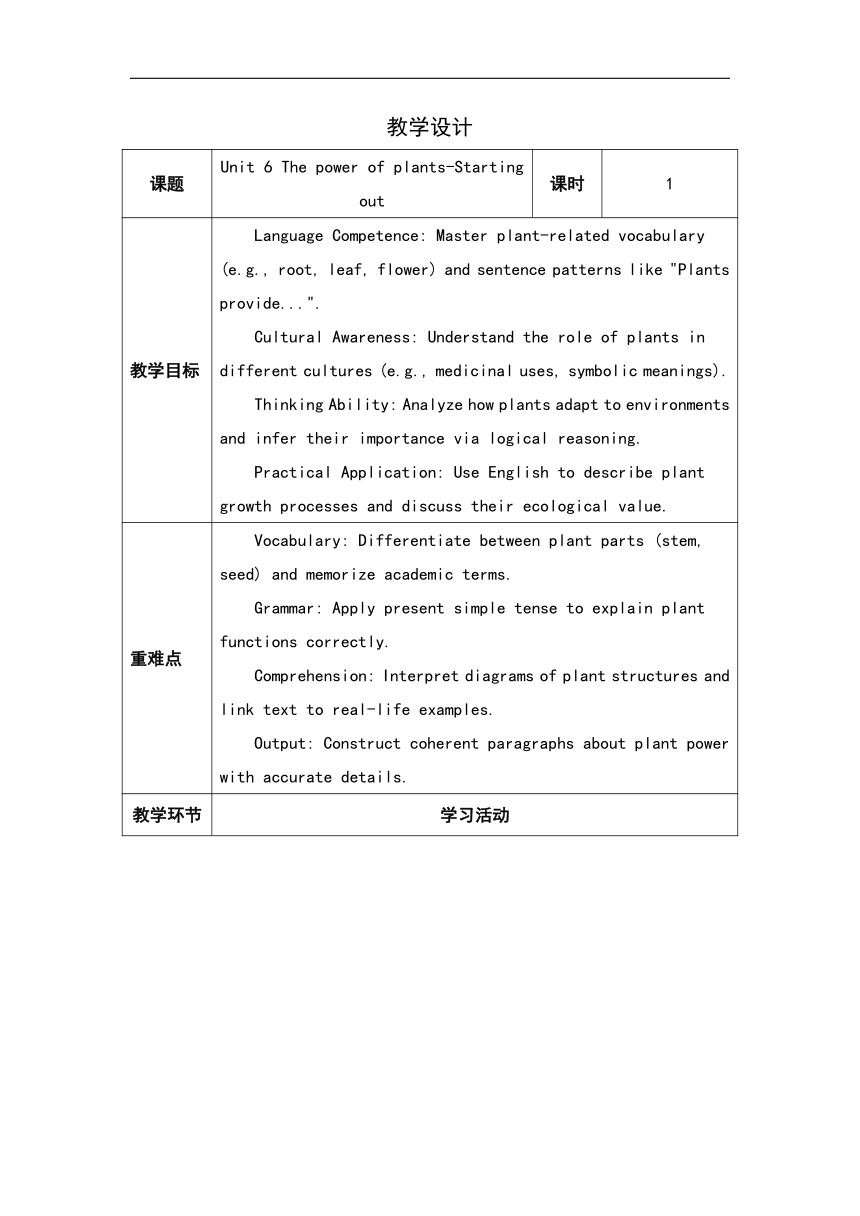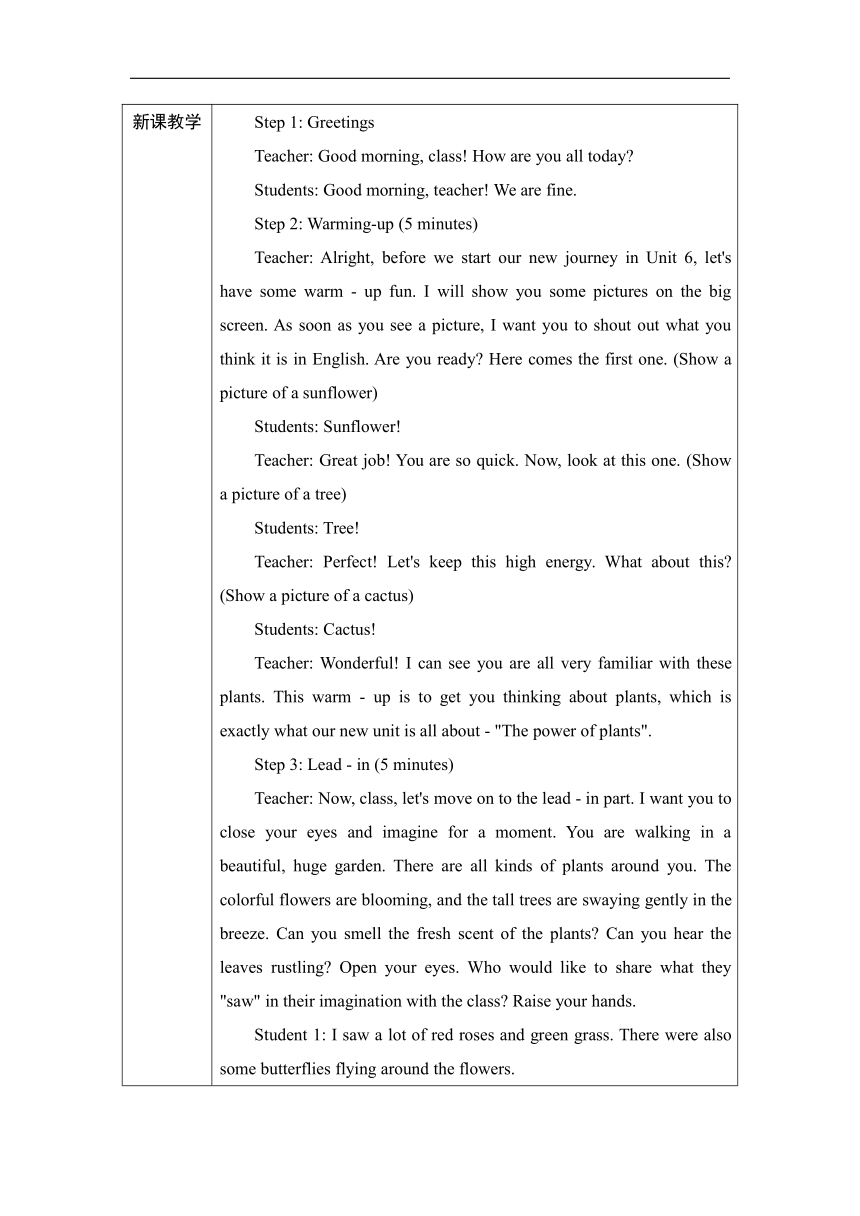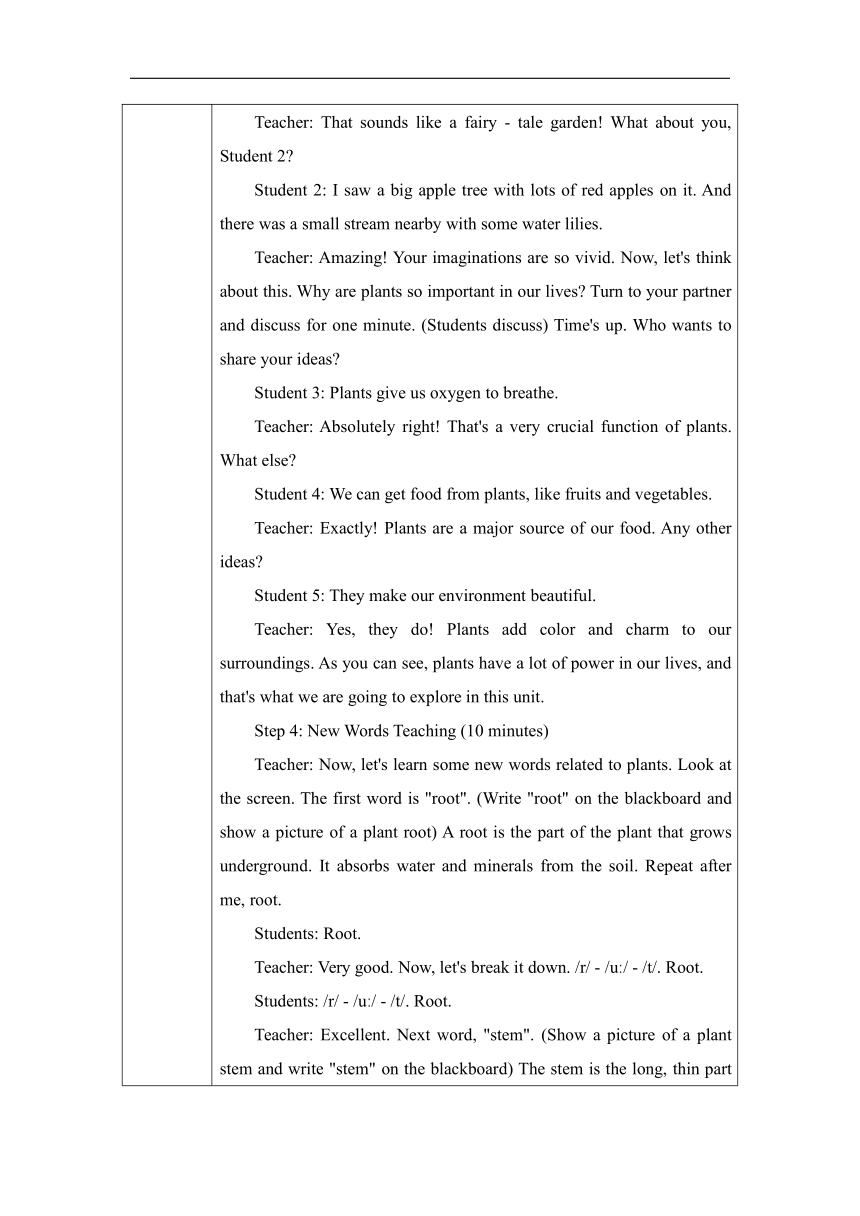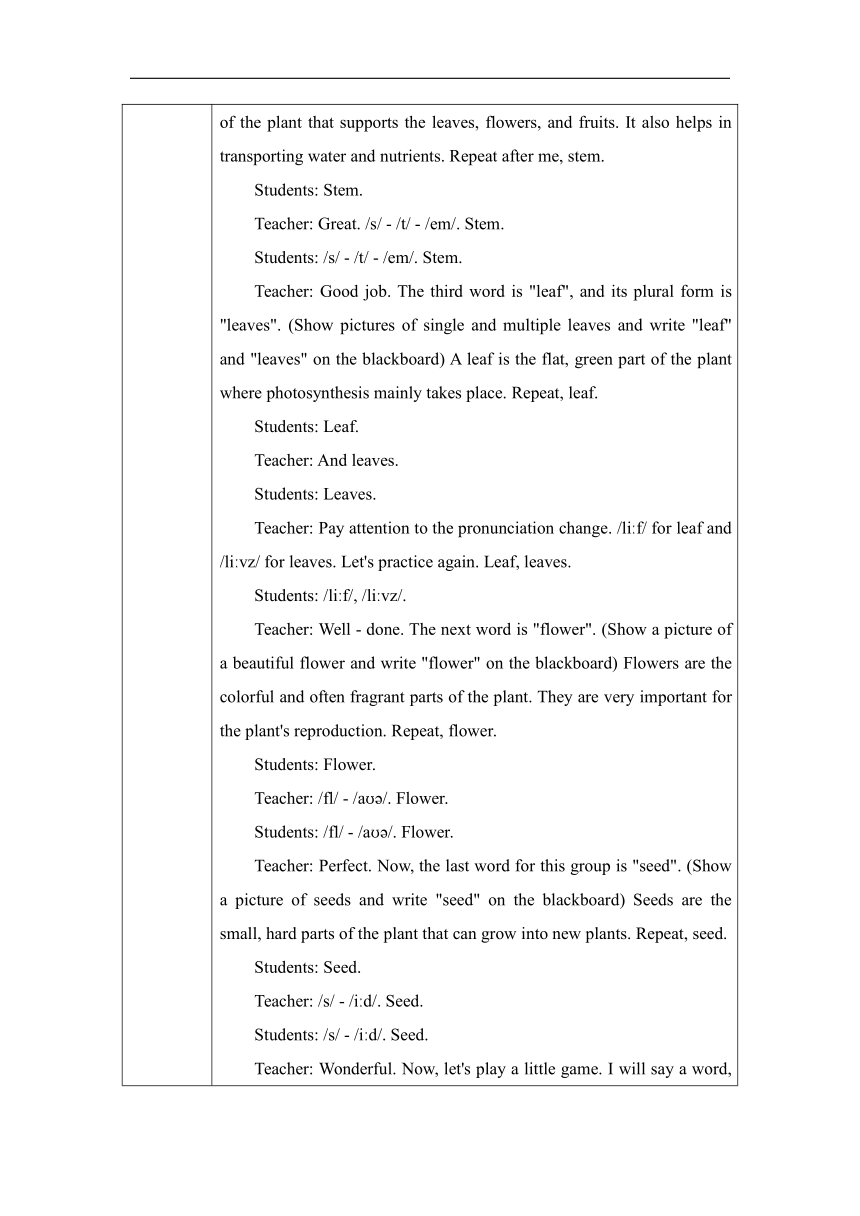Unit 6 The power of plants Starting out 教案(表格式)外研版(2024)英语七年级上册
文档属性
| 名称 | Unit 6 The power of plants Starting out 教案(表格式)外研版(2024)英语七年级上册 |  | |
| 格式 | docx | ||
| 文件大小 | 28.8KB | ||
| 资源类型 | 教案 | ||
| 版本资源 | 外研版 | ||
| 科目 | 英语 | ||
| 更新时间 | 2025-07-07 19:40:44 | ||
图片预览




文档简介
教学设计
课题 Unit 6 The power of plants-Starting out 课时 1
教学目标 Language Competence: Master plant-related vocabulary (e.g., root, leaf, flower) and sentence patterns like "Plants provide...". Cultural Awareness: Understand the role of plants in different cultures (e.g., medicinal uses, symbolic meanings). Thinking Ability: Analyze how plants adapt to environments and infer their importance via logical reasoning. Practical Application: Use English to describe plant growth processes and discuss their ecological value.
重难点 Vocabulary: Differentiate between plant parts (stem, seed) and memorize academic terms. Grammar: Apply present simple tense to explain plant functions correctly. Comprehension: Interpret diagrams of plant structures and link text to real-life examples. Output: Construct coherent paragraphs about plant power with accurate details.
教学环节 学习活动
新课教学 Step 1: Greetings Teacher: Good morning, class! How are you all today Students: Good morning, teacher! We are fine. Step 2: Warming-up (5 minutes) Teacher: Alright, before we start our new journey in Unit 6, let's have some warm - up fun. I will show you some pictures on the big screen. As soon as you see a picture, I want you to shout out what you think it is in English. Are you ready Here comes the first one. (Show a picture of a sunflower) Students: Sunflower! Teacher: Great job! You are so quick. Now, look at this one. (Show a picture of a tree) Students: Tree! Teacher: Perfect! Let's keep this high energy. What about this (Show a picture of a cactus) Students: Cactus! Teacher: Wonderful! I can see you are all very familiar with these plants. This warm - up is to get you thinking about plants, which is exactly what our new unit is all about - "The power of plants". Step 3: Lead - in (5 minutes) Teacher: Now, class, let's move on to the lead - in part. I want you to close your eyes and imagine for a moment. You are walking in a beautiful, huge garden. There are all kinds of plants around you. The colorful flowers are blooming, and the tall trees are swaying gently in the breeze. Can you smell the fresh scent of the plants Can you hear the leaves rustling Open your eyes. Who would like to share what they "saw" in their imagination with the class Raise your hands. Student 1: I saw a lot of red roses and green grass. There were also some butterflies flying around the flowers. Teacher: That sounds like a fairy - tale garden! What about you, Student 2 Student 2: I saw a big apple tree with lots of red apples on it. And there was a small stream nearby with some water lilies. Teacher: Amazing! Your imaginations are so vivid. Now, let's think about this. Why are plants so important in our lives Turn to your partner and discuss for one minute. (Students discuss) Time's up. Who wants to share your ideas Student 3: Plants give us oxygen to breathe. Teacher: Absolutely right! That's a very crucial function of plants. What else Student 4: We can get food from plants, like fruits and vegetables. Teacher: Exactly! Plants are a major source of our food. Any other ideas Student 5: They make our environment beautiful. Teacher: Yes, they do! Plants add color and charm to our surroundings. As you can see, plants have a lot of power in our lives, and that's what we are going to explore in this unit. Step 4: New Words Teaching (10 minutes) Teacher: Now, let's learn some new words related to plants. Look at the screen. The first word is "root". (Write "root" on the blackboard and show a picture of a plant root) A root is the part of the plant that grows underground. It absorbs water and minerals from the soil. Repeat after me, root. Students: Root. Teacher: Very good. Now, let's break it down. /r/ - /u / - /t/. Root. Students: /r/ - /u / - /t/. Root. Teacher: Excellent. Next word, "stem". (Show a picture of a plant stem and write "stem" on the blackboard) The stem is the long, thin part of the plant that supports the leaves, flowers, and fruits. It also helps in transporting water and nutrients. Repeat after me, stem. Students: Stem. Teacher: Great. /s/ - /t/ - /em/. Stem. Students: /s/ - /t/ - /em/. Stem. Teacher: Good job. The third word is "leaf", and its plural form is "leaves". (Show pictures of single and multiple leaves and write "leaf" and "leaves" on the blackboard) A leaf is the flat, green part of the plant where photosynthesis mainly takes place. Repeat, leaf. Students: Leaf. Teacher: And leaves. Students: Leaves. Teacher: Pay attention to the pronunciation change. /li f/ for leaf and /li vz/ for leaves. Let's practice again. Leaf, leaves. Students: /li f/, /li vz/. Teacher: Well - done. The next word is "flower". (Show a picture of a beautiful flower and write "flower" on the blackboard) Flowers are the colorful and often fragrant parts of the plant. They are very important for the plant's reproduction. Repeat, flower. Students: Flower. Teacher: /fl/ - /a /. Flower. Students: /fl/ - /a /. Flower. Teacher: Perfect. Now, the last word for this group is "seed". (Show a picture of seeds and write "seed" on the blackboard) Seeds are the small, hard parts of the plant that can grow into new plants. Repeat, seed. Students: Seed. Teacher: /s/ - /i d/. Seed. Students: /s/ - /i d/. Seed. Teacher: Wonderful. Now, let's play a little game. I will say a word, and you quickly point to the corresponding picture on the screen. Are you ready Root. Students (point to the picture of the root): This one! Teacher: Correct. Stem. Students (point to the picture of the stem): That one! Teacher: Well - done. Let's continue with leaf, flower, and seed one by one. (Repeat the game with all the new words) Step 5: Listening Activity (10 minutes) Teacher: Now that we know some new words, let's do a listening activity. I will play a short passage about plants. While you are listening, please fill in the blanks on your handouts with the words you hear. The words are the ones we just learned. Are you ready Here we go. (Play the recording) Recording: Plants are amazing living things. They have different parts. The root grows underground and takes in water and minerals. The stem supports the plant and helps transport substances. The leaves are green and are very important for photosynthesis. Beautiful flowers can be seen on many plants, and they play a role in reproduction. From the flowers, we get seeds which can grow into new plants. Teacher: Time's up. Let's check the answers together. For the first blank, what should we fill in Students: Root. Teacher: Right. And the second one Students: Stem. Teacher: Correct. How about the third one Students: Leaves. Teacher: Good. Fourth one Students: Flowers. Teacher: Well - done. And the last one Students: Seeds. Teacher: Perfect. This listening activity helps you not only practice listening skills but also get more familiar with the new words in context. Step 6: Group Discussion (10 minutes) Teacher: Now, class, I want you to form groups of four. In your groups, discuss the following question: If you could be a plant, which plant would you like to be and why You can use the new words we learned and any other words you know. You have five minutes to discuss. (Students form groups and start discussing) Teacher (going around the groups, listening and giving guidance): That's an interesting idea. Can you explain it in more detail Use the words we learned, like stem, leaf, or flower. Teacher: Time's up. Now, each group choose a representative to share your group's ideas with the whole class. Group 1, you go first. Group 1 Representative: We would like to be sunflowers. Because sunflowers have big, bright flowers. Their stems are tall and strong, which can support the big flower heads. And the leaves are large, which can do a lot of photosynthesis. Also, sunflowers always face the sun, and they look so positive. Teacher: That's a great choice and a wonderful explanation. Group 2, your turn. Group 2 Representative: We want to be bamboo. Bamboo has a lot of long, straight stems. It grows very fast. The leaves are thin and green. It can be used to make many things, like furniture. And bamboo forests are very beautiful. Teacher: Fantastic! Bamboo is really a useful and special plant. Group 3 Group 3 Representative: We would choose cactus. Cactus has thick stems that can store water. Its leaves have turned into thorns to prevent water loss. It can survive in very dry places. We think it's very tough. Teacher: Excellent! You really understand the characteristics of cactus. Group 4 Group 4 Representative: We like roses. Roses have beautiful, colorful flowers with nice fragrance. Their stems have thorns, which can protect them. The leaves are green and smooth. Roses are often used to express love. Teacher: Wonderful! I can see you all had very interesting discussions in your groups. Step 7: Summary (5 minutes) Teacher: Class, let's summarize what we have learned today. First, we learned some new words about plants, such as root, stem, leaf, flower, and seed. Then, we did a listening activity to practice using these words in context. Finally, we had a great group discussion about which plant we would like to be. Can anyone tell me why it's important to learn about plants in English Student 6: Because plants are everywhere in our lives, and if we learn about them in English, we can talk about them with people from other countries. Teacher: That's a very good point. Learning about plants in English helps us communicate about an important part of our world. Also, it enriches our vocabulary and language skills. So, keep learning and exploring the amazing world of plants in English. Step 8: Homework Assignment (5 minutes) Teacher: For homework today, I want you to draw a plant that you like the most. On the drawing, label all the parts we learned today - root, stem, leaf, flower (if it has one), and seed (if applicable). Then, write a short paragraph in English to describe your plant. You can talk about its appearance, why you like it, or anything interesting about it. Make sure to use at least five sentences. This will help you review what we learned today and also let your creativity shine. Do you have any questions about the homework Students: No, teacher. Teacher: Great. I'm looking forward to seeing your beautiful drawings and wonderful descriptions. That's all for today's class. Have a great day!
课题 Unit 6 The power of plants-Starting out 课时 1
教学目标 Language Competence: Master plant-related vocabulary (e.g., root, leaf, flower) and sentence patterns like "Plants provide...". Cultural Awareness: Understand the role of plants in different cultures (e.g., medicinal uses, symbolic meanings). Thinking Ability: Analyze how plants adapt to environments and infer their importance via logical reasoning. Practical Application: Use English to describe plant growth processes and discuss their ecological value.
重难点 Vocabulary: Differentiate between plant parts (stem, seed) and memorize academic terms. Grammar: Apply present simple tense to explain plant functions correctly. Comprehension: Interpret diagrams of plant structures and link text to real-life examples. Output: Construct coherent paragraphs about plant power with accurate details.
教学环节 学习活动
新课教学 Step 1: Greetings Teacher: Good morning, class! How are you all today Students: Good morning, teacher! We are fine. Step 2: Warming-up (5 minutes) Teacher: Alright, before we start our new journey in Unit 6, let's have some warm - up fun. I will show you some pictures on the big screen. As soon as you see a picture, I want you to shout out what you think it is in English. Are you ready Here comes the first one. (Show a picture of a sunflower) Students: Sunflower! Teacher: Great job! You are so quick. Now, look at this one. (Show a picture of a tree) Students: Tree! Teacher: Perfect! Let's keep this high energy. What about this (Show a picture of a cactus) Students: Cactus! Teacher: Wonderful! I can see you are all very familiar with these plants. This warm - up is to get you thinking about plants, which is exactly what our new unit is all about - "The power of plants". Step 3: Lead - in (5 minutes) Teacher: Now, class, let's move on to the lead - in part. I want you to close your eyes and imagine for a moment. You are walking in a beautiful, huge garden. There are all kinds of plants around you. The colorful flowers are blooming, and the tall trees are swaying gently in the breeze. Can you smell the fresh scent of the plants Can you hear the leaves rustling Open your eyes. Who would like to share what they "saw" in their imagination with the class Raise your hands. Student 1: I saw a lot of red roses and green grass. There were also some butterflies flying around the flowers. Teacher: That sounds like a fairy - tale garden! What about you, Student 2 Student 2: I saw a big apple tree with lots of red apples on it. And there was a small stream nearby with some water lilies. Teacher: Amazing! Your imaginations are so vivid. Now, let's think about this. Why are plants so important in our lives Turn to your partner and discuss for one minute. (Students discuss) Time's up. Who wants to share your ideas Student 3: Plants give us oxygen to breathe. Teacher: Absolutely right! That's a very crucial function of plants. What else Student 4: We can get food from plants, like fruits and vegetables. Teacher: Exactly! Plants are a major source of our food. Any other ideas Student 5: They make our environment beautiful. Teacher: Yes, they do! Plants add color and charm to our surroundings. As you can see, plants have a lot of power in our lives, and that's what we are going to explore in this unit. Step 4: New Words Teaching (10 minutes) Teacher: Now, let's learn some new words related to plants. Look at the screen. The first word is "root". (Write "root" on the blackboard and show a picture of a plant root) A root is the part of the plant that grows underground. It absorbs water and minerals from the soil. Repeat after me, root. Students: Root. Teacher: Very good. Now, let's break it down. /r/ - /u / - /t/. Root. Students: /r/ - /u / - /t/. Root. Teacher: Excellent. Next word, "stem". (Show a picture of a plant stem and write "stem" on the blackboard) The stem is the long, thin part of the plant that supports the leaves, flowers, and fruits. It also helps in transporting water and nutrients. Repeat after me, stem. Students: Stem. Teacher: Great. /s/ - /t/ - /em/. Stem. Students: /s/ - /t/ - /em/. Stem. Teacher: Good job. The third word is "leaf", and its plural form is "leaves". (Show pictures of single and multiple leaves and write "leaf" and "leaves" on the blackboard) A leaf is the flat, green part of the plant where photosynthesis mainly takes place. Repeat, leaf. Students: Leaf. Teacher: And leaves. Students: Leaves. Teacher: Pay attention to the pronunciation change. /li f/ for leaf and /li vz/ for leaves. Let's practice again. Leaf, leaves. Students: /li f/, /li vz/. Teacher: Well - done. The next word is "flower". (Show a picture of a beautiful flower and write "flower" on the blackboard) Flowers are the colorful and often fragrant parts of the plant. They are very important for the plant's reproduction. Repeat, flower. Students: Flower. Teacher: /fl/ - /a /. Flower. Students: /fl/ - /a /. Flower. Teacher: Perfect. Now, the last word for this group is "seed". (Show a picture of seeds and write "seed" on the blackboard) Seeds are the small, hard parts of the plant that can grow into new plants. Repeat, seed. Students: Seed. Teacher: /s/ - /i d/. Seed. Students: /s/ - /i d/. Seed. Teacher: Wonderful. Now, let's play a little game. I will say a word, and you quickly point to the corresponding picture on the screen. Are you ready Root. Students (point to the picture of the root): This one! Teacher: Correct. Stem. Students (point to the picture of the stem): That one! Teacher: Well - done. Let's continue with leaf, flower, and seed one by one. (Repeat the game with all the new words) Step 5: Listening Activity (10 minutes) Teacher: Now that we know some new words, let's do a listening activity. I will play a short passage about plants. While you are listening, please fill in the blanks on your handouts with the words you hear. The words are the ones we just learned. Are you ready Here we go. (Play the recording) Recording: Plants are amazing living things. They have different parts. The root grows underground and takes in water and minerals. The stem supports the plant and helps transport substances. The leaves are green and are very important for photosynthesis. Beautiful flowers can be seen on many plants, and they play a role in reproduction. From the flowers, we get seeds which can grow into new plants. Teacher: Time's up. Let's check the answers together. For the first blank, what should we fill in Students: Root. Teacher: Right. And the second one Students: Stem. Teacher: Correct. How about the third one Students: Leaves. Teacher: Good. Fourth one Students: Flowers. Teacher: Well - done. And the last one Students: Seeds. Teacher: Perfect. This listening activity helps you not only practice listening skills but also get more familiar with the new words in context. Step 6: Group Discussion (10 minutes) Teacher: Now, class, I want you to form groups of four. In your groups, discuss the following question: If you could be a plant, which plant would you like to be and why You can use the new words we learned and any other words you know. You have five minutes to discuss. (Students form groups and start discussing) Teacher (going around the groups, listening and giving guidance): That's an interesting idea. Can you explain it in more detail Use the words we learned, like stem, leaf, or flower. Teacher: Time's up. Now, each group choose a representative to share your group's ideas with the whole class. Group 1, you go first. Group 1 Representative: We would like to be sunflowers. Because sunflowers have big, bright flowers. Their stems are tall and strong, which can support the big flower heads. And the leaves are large, which can do a lot of photosynthesis. Also, sunflowers always face the sun, and they look so positive. Teacher: That's a great choice and a wonderful explanation. Group 2, your turn. Group 2 Representative: We want to be bamboo. Bamboo has a lot of long, straight stems. It grows very fast. The leaves are thin and green. It can be used to make many things, like furniture. And bamboo forests are very beautiful. Teacher: Fantastic! Bamboo is really a useful and special plant. Group 3 Group 3 Representative: We would choose cactus. Cactus has thick stems that can store water. Its leaves have turned into thorns to prevent water loss. It can survive in very dry places. We think it's very tough. Teacher: Excellent! You really understand the characteristics of cactus. Group 4 Group 4 Representative: We like roses. Roses have beautiful, colorful flowers with nice fragrance. Their stems have thorns, which can protect them. The leaves are green and smooth. Roses are often used to express love. Teacher: Wonderful! I can see you all had very interesting discussions in your groups. Step 7: Summary (5 minutes) Teacher: Class, let's summarize what we have learned today. First, we learned some new words about plants, such as root, stem, leaf, flower, and seed. Then, we did a listening activity to practice using these words in context. Finally, we had a great group discussion about which plant we would like to be. Can anyone tell me why it's important to learn about plants in English Student 6: Because plants are everywhere in our lives, and if we learn about them in English, we can talk about them with people from other countries. Teacher: That's a very good point. Learning about plants in English helps us communicate about an important part of our world. Also, it enriches our vocabulary and language skills. So, keep learning and exploring the amazing world of plants in English. Step 8: Homework Assignment (5 minutes) Teacher: For homework today, I want you to draw a plant that you like the most. On the drawing, label all the parts we learned today - root, stem, leaf, flower (if it has one), and seed (if applicable). Then, write a short paragraph in English to describe your plant. You can talk about its appearance, why you like it, or anything interesting about it. Make sure to use at least five sentences. This will help you review what we learned today and also let your creativity shine. Do you have any questions about the homework Students: No, teacher. Teacher: Great. I'm looking forward to seeing your beautiful drawings and wonderful descriptions. That's all for today's class. Have a great day!
同课章节目录
